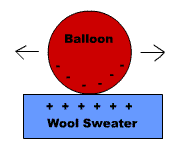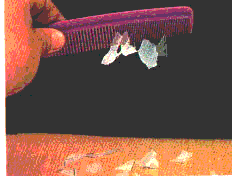|
Static electricity is the situation
where electrical charges build up on the surface of a
material. It is called �static� because there is no
current flowing as in AC or DC electricity. Static
electricity is usually caused when materials are rubbed
together. The result is that objects may be attracted to
each other or may even cause a spark to jump from one
object to the other. Common examples of static
electricity in action are static cling, flyaway hair and
the sparks that can occur when you touch something.
Questions you may have include:
What causes static electricity?
Why do things attract or repel?
What causes a spark?
Cause of static electricity
Static electricity is usually caused
when certain materials are rubbed against each other,
like wool on plastic or the soles of your shoes on the
carpet. The process causes electrons to be pulled from
the surface of one material and relocated on the surface
of the other material.

Rubbing a
balloon on a wool sweater creates charges on the
surfaces
The material that loses electrons ends
up with an excess of positive (+) charges. The material
that gains electrons ends up an excess of negative (-)
charges on its surface.
The gain or loss of electrons can be
explained by recalling that atoms consist of a nucleus
of neutrons and positively charged protons, surrounded
by negatively charged electrons. Normally, there is the
same number of electrons as protons in each atom.
But if some object pulls away electrons
from their orbit or shell around the nucleus, that
causes the atom to have a positive charge because it has
more protons than electrons. Likewise, the other
material will have extra electrons in its shell, giving
the atoms a negative charge.
Note that the charged atoms are on the
surface of the material. Static electricity is different
than regular electricity that flows through metal wires.
Most of the time the materials involved in static
electricity are nonconductors of electricity.
If electrical charges build up on the
outside of a metal, most of them will dissipate into the
metal, similar to an electrical current.
When the air is humid, water molecules
can collect on the surface of various materials. This
can prevent the buildup of electrical charges. The
reason has to do with the shape of the water molecule
and its own electrical forces.
Thus, static electricity is formed much
better when the air is dry or the humidity is low.
Force field causes attraction
An object that has static electricity
charges built up on its surface has an electrical force
field coming from the surface. This field will mildly
attract neutral objects or those with no charge. The
field will strongly attract an object that has an
opposite charge on its surface. From this we get the
expression: "Opposites attract."
If two objects have the same charge, the
electrical force field will cause those objects to push
away from each other or repel.
Rub a balloon on a wool sweater. The
balloon collects negative electrical charges on its
surface and the wool collects positive charges. You can
then stick the balloon to the wall, which does not have
an excess of either charge. The balloon will also stick
to the wool, although the charges may jump back to the
original material in a short time.
You can also run a comb through your
hair to charge the comb with static electricity. The
comb can then be used to attract neutral pieces of
tissue.

Picking up
tissue with a comb
Comb your hair on a dry day or after
using a hair drier. The plastic comb collects negative
charges from the hair, causing the hair to have an
excess of positive charges. Since like charges repel,
the hair strand will tend to push away from each other,
causing the "flyaway hair" effect.
Why sparks fly
When two objects that have opposite
charges get near each other, the electrical field pulls
them together.
What actually happens is that the
negatively charged (-) electrons are attracted to the
atoms in the other material that have an excess positive
(+) charge. Things are much more stable if all the atoms
have an equal number of (+) and (-) charges.
The reason the electrons can't leave
their present material is because of strong molecular
forces that keep them where they are. If there are
enough positive (+) charges attracting them, and the
distance is not too great, some of the electrons will
break loose and fly across the gap to the (+) side.
Once a few electrons start to move
across the gap, they heat up the air, such that more and
more will jump across the gap. This heats the air even
more. It all happens very fast, and the air gets so hot
that it glows for a short time. That is a spark.
The same thing happens with lightning,
except on a much larger scale, with higher voltages and
current.
Ben Franklin proved that lightning was
static electricity by flying a kite in a storm and
detecting static electricity by seeing the hairs on the
kite string stand on end and creating a spark with a
metal key. This dangerous experiment showed that static
electricity was being formed in the clouds by the rain.
Rubbing certain materials together can
cause the buildup of electrical charges on the surfaces.
Opposite charges attract and same charges repel. Either
charge will be attracted to something of neutral charge.
Sparks are an extreme case of electrons being attracted
to an object that has a positive charge. |